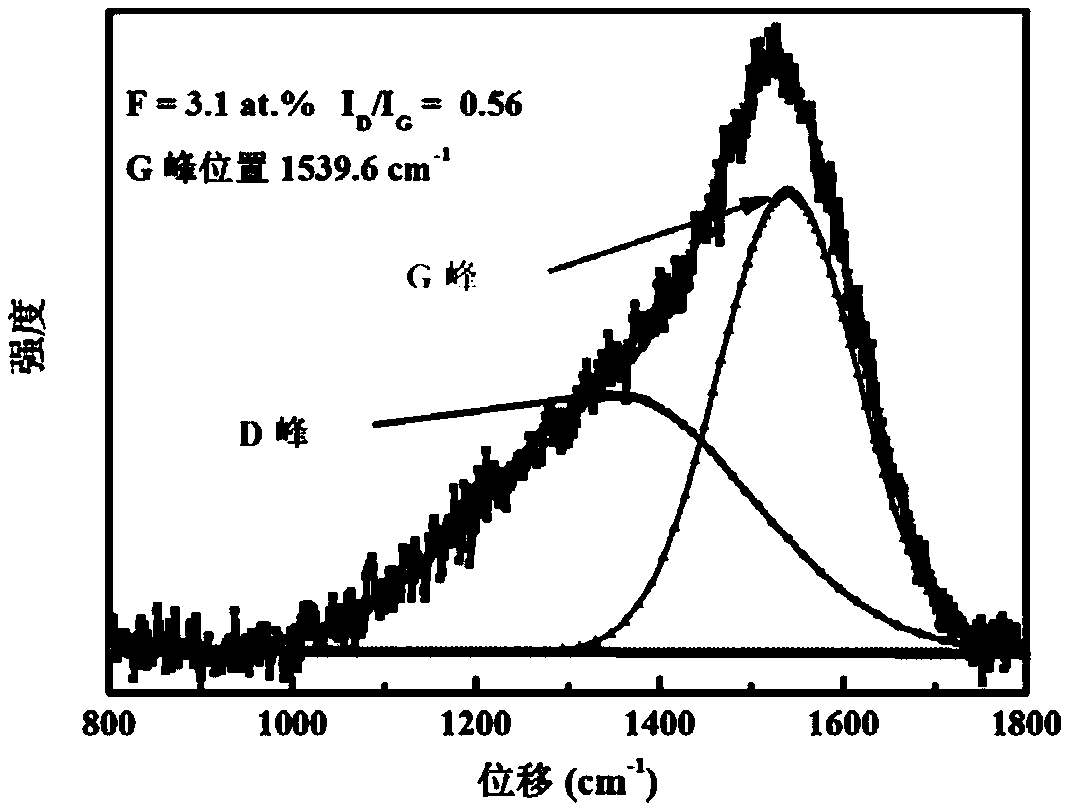Method for preparing anti-friction and anti-wear f-dlc film on titanium alloy surface
A F-DLC, anti-friction and anti-wear technology, applied in the direction of metal material coating process, coating, gaseous chemical plating, etc., to achieve the effects of high adhesion, improved tribological properties, and high hardness
- Summary
- Abstract
- Description
- Claims
- Application Information
AI Technical Summary
Problems solved by technology
Method used
Image
Examples
Embodiment 1
[0021] To prepare anti-friction and anti-wear F-DLC film on the surface of titanium alloy Ti-6Al-4V substrate, follow the steps below:
[0022] 1) Pretreatment: Polish the Ti-6Al-4V surface to reduce its surface roughness to less than 10nm, then immerse it in acetone and alcohol solvent for ultrasonic cleaning for 15 minutes to remove dirt on the alloy surface, and use nitrogen to blow Dry spare.
[0023] 2) Sputtering cleaning: Put the dried Ti-6Al-4V into the middle of two parallel plates in the reaction chamber of HP-PECVD deposition system, and vacuum the reaction chamber. When the pressure of the reaction chamber is lower than 10 -4 At Pa, let argon gas and keep the reaction chamber pressure at 1.3 Pa, apply pulse bias -8kV on the plate, control the duty cycle to 15%, and pulse frequency to 1200Hz, splash the Ti-6Al-4V in the reaction chamber Spray cleaning for 20 minutes.
[0024] 3) Depositing the Si transition layer: After the sputtering cleaning is completed, pass SiH into ...
Embodiment 2
[0028] To prepare anti-friction and anti-wear F-DLC film on the surface of titanium alloy Ti-6Al-4V substrate, follow the steps below:
[0029] 1) Pretreatment: Polish the Ti-6Al-4V surface to reduce its surface roughness to less than 10nm, then immerse it in acetone and alcohol solvent for ultrasonic cleaning for 20 minutes to remove dirt on the alloy surface, and then use nitrogen Blow dry and set aside.
[0030] 2) Sputtering cleaning: Put the dried Ti-6Al-4V into the middle of two parallel plates in the reaction chamber of HP-PECVD deposition system, and vacuum the reaction chamber. When the pressure of the reaction chamber is lower than 10 -4 At Pa, pass argon gas and keep the pressure of the reaction chamber at 2.0 Pa, apply a pulse bias voltage of -13kV on the plate, control the duty cycle to 25%, and the pulse frequency to 1500Hz. Splash the Ti-6Al-4V in the reaction chamber Spray cleaning for 30 minutes.
[0031] 3) Depositing the Si transition layer: After the sputtering c...
Embodiment 3
[0035] To prepare anti-friction and anti-wear F-DLC film on the surface of titanium alloy Ti-6Al-4V substrate, follow the steps below:
[0036] 1) Pretreatment: Polish the Ti-6Al-4V surface to reduce the surface roughness to below 10nm, then immerse it in acetone and alcohol solvent for ultrasonic cleaning for 30 minutes to remove dirt on the alloy surface, and then use nitrogen Blow dry and set aside.
[0037] 2) Sputtering cleaning: Put the dried Ti-6Al-4V into the middle of two parallel plates in the reaction chamber of HP-PECVD deposition system, and vacuum the reaction chamber. When the pressure of the reaction chamber is lower than 10 -4 At Pa, pass argon gas and keep the pressure in the reaction chamber at 2.5 Pa, apply pulse bias -15kV on the plate, control the duty cycle to 35%, and the pulse frequency to 1500Hz. Splash the Ti-6Al-4V in the reaction chamber Spray cleaning for 28min.
[0038] 3) Depositing the Si transition layer: After the sputtering cleaning is completed, ...
PUM
| Property | Measurement | Unit |
|---|---|---|
| wear rate | aaaaa | aaaaa |
| wear rate | aaaaa | aaaaa |
| wear rate | aaaaa | aaaaa |
Abstract
Description
Claims
Application Information
 Login to View More
Login to View More - R&D
- Intellectual Property
- Life Sciences
- Materials
- Tech Scout
- Unparalleled Data Quality
- Higher Quality Content
- 60% Fewer Hallucinations
Browse by: Latest US Patents, China's latest patents, Technical Efficacy Thesaurus, Application Domain, Technology Topic, Popular Technical Reports.
© 2025 PatSnap. All rights reserved.Legal|Privacy policy|Modern Slavery Act Transparency Statement|Sitemap|About US| Contact US: help@patsnap.com



